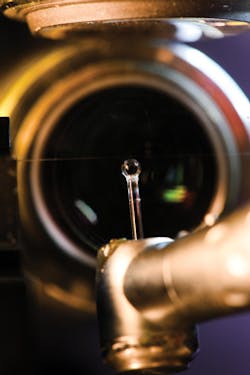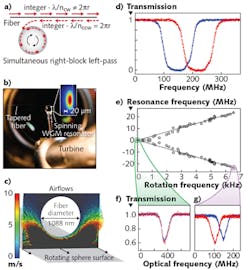Optical Isolators: The light valve: a rapidly spinning glass sphere isolates light
Optical isolators—components that transmit light in only one direction and block it in another—are crucial for protecting laser sources from back reflections and/or routing or blocking light signals in optical communications networks.
In the quest to develop a smaller, higher-efficiency optical isolator design that improves upon the bulky, complex interference filter-, grating-, or magneto-optical-material-based designs, researchers at the Technion-Israel Institute of Technology (Haifa, Israel), in collaboration with researchers from the University of Central Florida (Orlando, FL), the University of Michigan (Ann Arbor, MI), and Hunan Normal University (Changsha, China), have developed an optical isolator based on a rapidly rotating glass sphere that drags light to slow it down or speed it up, depending on its direction.1
An optical isolator consists of a section of tapered optical fiber (the empty circle) floating on the flow of wind generated at the tip of a rotating glass sphere (in gray at the bottom), and operates by either blocking or transmitting light injected at the taper in the direction of rotation or counter to it, respectively. (Image credit: Technion-Israel Institute of Technology)
Fizeau drag
As described in 1849 by French scientist Hippolyte Fizeau (see https://en.wikipedia.org/wiki/fizeau_experiment), the speed of light in a moving medium (like a swimmer in a flowing river) is faster in the direction of movement and slower in the opposite direction (like a swimmer heading upstream). Fizeau’s discovery influenced Einstein’s Theory of Special Relativity, and the researchers feel that the “Fizeau drag” effect may lead to significant applications in integrated optics and quantum communication.
Recognizing this principle of light’s behavior in a moving medium, the glass-blowing team at Technion formed a small (around 1 mm radius) glass sphere from the tip of a silica glass rod. Light enters the sphere via both sides of a standard 125-µm-diameter glass fiber that has been tapered to a diameter of around 1 µm and positioned a few tens of nanometers from the surface of the sphere. Acting as a resonator, the sphere’s rim rotates at an ultrafast 300 km/hr (see figure).
To maintain the nanometer-scale distance between the tapered fiber and the rapidly rotating sphere, the team designed the isolator such that the fiber actually floats on the airflow or wind generated by the rotation of the sphere, ensuring that if the isolator moves or wobbles, the fiber will wobble with it and maintain the taper-sphere separation distance.
At the sphere surface, the light approaching from the right side of the taper moves along the circumference of the sphere in the direction of rotation, while the light approaching from the left moves counter to the sphere motion and, consequently, at a slower speed. Basically, the isolator transmits light approaching from the left and blocks the light from the right. Why? Just like a musical instrument that resonates at a specific frequency, light circumferentially circulating in the sphere resonantly echoes and circulates thousands of times within the sphere—eventually being absorbed. But the non-resonating light from the left passes through the isolator essentially undisturbed.
The tens-of-nanometers separation allows access to strong forces that are dominating at such distances. Among these are Casimir forces originating from the quantum properties of vacuum and Van der Waals forces—such forces are rarely used in mechanical applications.
“Essentially, we developed a very efficient photonic isolator that can isolate 99.6% of the light,” says Technion research team leader and professor Tal Carmon. “When we inflate a bicycle tire, we let air flow into the tube while at the same time, blocking the air from flowing out. Such a simple degree of control is quite challenging when it comes to light, but our mechanical degree of freedom in the form of a rotating sphere positioned near a tapered fiber precisely controls the transmission and absorption of the light. We believe that more and more optical devices will use dynamic elements and self-aligned nano-distance-control, as we do here, to allow investigations of optomechanics at nano-separations where forces, enormous in their strength, are predicted to dominate.”
REFERENCE
1. See https://goo.gl/vBqjx4.

Gail Overton | Senior Editor (2004-2020)
Gail has more than 30 years of engineering, marketing, product management, and editorial experience in the photonics and optical communications industry. Before joining the staff at Laser Focus World in 2004, she held many product management and product marketing roles in the fiber-optics industry, most notably at Hughes (El Segundo, CA), GTE Labs (Waltham, MA), Corning (Corning, NY), Photon Kinetics (Beaverton, OR), and Newport Corporation (Irvine, CA). During her marketing career, Gail published articles in WDM Solutions and Sensors magazine and traveled internationally to conduct product and sales training. Gail received her BS degree in physics, with an emphasis in optics, from San Diego State University in San Diego, CA in May 1986.

